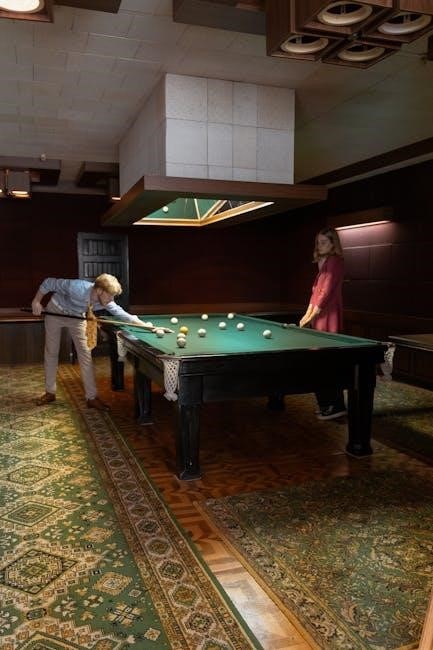A Dark Room is a minimalist, text-based survival game that challenges players to manage resources, craft items, and explore a mysterious world. Starting with a dimly lit room, the game gradually reveals its depth, requiring strategic thinking and imagination. Its slow-burning narrative and simple interface create a unique, immersive experience.
Overview of the Game
A Dark Room is a captivating text-based indie game that blends elements of survival, strategy, and exploration. The game begins with the player awakening in a mysterious, dimly lit room with no clear memory of how they arrived there. As the story unfolds, the player must manage resources, craft items, and gradually uncover the secrets of the world.
The game’s minimalist design and lack of visual flourishes are intentional, forcing players to rely on their imagination and the text-based interface. Starting with basic tasks like stoking a fire, the game introduces players to a world where resource management is crucial. As progress is made, the player can expand their efforts, building structures, trading with strangers, and exploring a desolate landscape.
One of the standout features of A Dark Room is its slow-burning narrative. The game reveals its mechanics and story gradually, creating a sense of mystery and discovery. Players must balance short-term survival needs with long-term goals, such as building a community and escaping the confines of the dark room.
The game’s simplicity belies its depth, offering a unique blend of strategy and storytelling. With no hand-holding or tutorials, players are left to experiment and learn through trial and error. This approach fosters a sense of accomplishment as players overcome challenges and unravel the game’s enigmatic world.
History and Development
A Dark Room was originally created by Michael Townsend, an independent game developer, and released on June 13, 2013. The game gained popularity due to its minimalist design and engaging gameplay, which inspired a dedicated community of players. The mobile version was later developed by Amir Rajan, further expanding the game’s reach across platforms like iOS and Android.
The game was initially conceived as a simple text-based survival experience, but it evolved into a deeper, more complex adventure. Its open-source nature allowed players and developers to contribute to its growth, fostering a collaborative community. Over time, A Dark Room became available on multiple platforms, including Steam and Itch.io, where it continued to attract a loyal fanbase.
Despite its minimalist interface, the game’s development was meticulous, with a focus on creating a slow-burning narrative and immersive atmosphere. The lack of visual elements was intentional, forcing players to rely on their imagination and the game’s subtle cues. This approach resonated with players seeking a unique, challenging experience.
The game’s success led to the formation of Doublespeak Games, which oversees its distribution and updates. A Dark Room has been praised for its ability to balance simplicity with depth, making it a standout title in the indie gaming scene. Its history reflects the power of community-driven development and the enduring appeal of innovative game design.

Unique Features of the Game

A Dark Room stands out for its minimalist, text-based design, offering a unique blend of simplicity and depth. The game begins with a cryptic scenario, awakening in a cold, dark room, and gradually unfolds into a complex adventure. Its slow reveal of mechanics and narrative elements creates a sense of mystery, encouraging players to explore and experiment.
One of the game’s most distinctive features is its minimalist interface, which relies on text and limited visual cues. This design forces players to rely on their imagination, making the experience deeply personal and immersive. The lack of hand-holding or tutorials adds to the challenge, as players must figure out how to survive and progress through trial and error.
The game’s open-world exploration and resource management systems are also notable. As players progress, they can gather resources, craft items, and build structures, eventually establishing a thriving community. The ability to trade and interact with strangers adds depth to the gameplay, while the overarching narrative slowly reveals the world’s secrets.
Another unique aspect is the game’s open-source nature, which has fostered a strong community of players and contributors. This collaborative spirit has led to various mods and expansions, further enhancing the game’s longevity. A Dark Room is a testament to the power of minimalist design and player-driven creativity, making it a standout title in the indie gaming landscape.
Getting Started
Getting Started in A Dark Room begins with awakening in a mysterious, dimly lit room. The initial focus is on survival, managing resources like wood and fire. As you progress, you can gather food, build structures, and expand your community, setting the foundation for exploration and trade.
Starting the Game
Starting A Dark Room drops you into a mysterious, dimly lit room with no clear direction. The game begins with the protagonist awakening, disoriented, and tasked with survival. The minimalist interface presents text-based prompts, requiring you to make immediate decisions. Your first objective is to stoke the fire, which is essential for warmth and progress. As you interact with the environment, you’ll discover the need to manage resources like wood and food. The game’s slow reveal of mechanics encourages experimentation and learning through trial and error. Initially, the focus is on basic survival, but as you progress, new opportunities emerge, such as crafting tools, building structures, and interacting with strangers. The game’s minimalist design and lack of hand-holding create a sense of immersion and challenge, making every decision feel impactful. By carefully managing your actions and resources, you’ll gradually uncover the world beyond the dark room, setting the stage for exploration and community-building.

Resource Management Basics
Resource management is the cornerstone of survival in A Dark Room. The game requires you to carefully balance the collection and utilization of resources such as wood, food, and water. Wood is crucial for maintaining the fire, which prevents the room from becoming cold and hostile. Neglecting the fire can lead to dire consequences, making it essential to allocate resources efficiently. As you progress, you’ll encounter additional resources like stone, metal, and cloth, each with specific uses in crafting and building. The game introduces a day-night cycle, with resource generation rates varying over time. This adds a layer of strategy, as you must plan ahead to ensure a steady supply; Managing resources effectively allows you to construct huts, which provide shelter for villagers, enabling you to expand your community and unlock new capabilities. The game’s minimalist interface means you must pay close attention to resource counts and usage rates. Balancing immediate needs with long-term goals is key to thriving in the harsh world of A Dark Room. Proper resource management not only ensures survival but also paves the way for exploration and advancement, making it a fundamental skill for success.

Building and Crafting

Building and crafting are essential for progress in A Dark Room. Constructing structures like huts and facilities expands your village, supporting more villagers to gather resources. Crafting combines materials to create tools, enhancing survival and exploration capabilities. Both systems are vital for advancing and thriving in the game, ensuring long-term success.
Constructing Structures
Constructing structures is a cornerstone of progress in A Dark Room. Early in the game, you’ll focus on building basic huts to house villagers, which allows you to expand your workforce. As you gather resources, you can construct additional buildings like farms, water pumps, and workshops. Each structure serves a specific purpose, such as increasing resource production or enabling new crafting options.
The cost of constructing buildings increases as you progress, requiring careful resource management. For example, huts may initially cost a few pieces of wood, but later structures demand more materials, such as metal or advanced resources. Prioritizing which buildings to construct first is crucial, as they unlock new capabilities and improve efficiency.
Structures also play a role in story progression. As your village grows, new areas and opportunities become available, such as exploration of surrounding regions. Building certain facilities can also unlock special items or interactions, adding depth to the game’s narrative and mechanics. The ability to construct and upgrade structures is central to overcoming challenges and achieving long-term success in A Dark Room.
Crafting System
The crafting system in A Dark Room is a vital component of progression and survival. Initially, you’ll focus on crafting basic items like torches and tools, which are essential for resource gathering and exploration. As you advance, the crafting system evolves, allowing you to create more complex items such as weapons, armor, and advanced tools.
Crafting requires specific combinations of resources, such as wood, stone, and metal, which must be gathered or produced by your villagers. The game introduces new crafting recipes gradually, often tied to story milestones or the discovery of new areas. For example, crafting a pickaxe unlocks the ability to mine deeper into the earth, revealing rare resources and hidden secrets.
The crafting system also ties into the game’s narrative, as certain items are required to progress through the story or interact with non-playable characters (NPCs). Crafting becomes more intricate as you unlock new technologies and structures, enabling the creation of items that aid in exploration, trade, and combat. The system rewards experimentation and strategic planning, making it a core part of the A Dark Room experience.
Ultimately, the crafting system serves as a bridge between resource management and exploration, driving the player forward in a world that is as mysterious as it is unforgiving. By mastering the crafting mechanics, players can overcome challenges and unlock the full potential of the game.

Exploration and Trade
Exploration and trade are cornerstone mechanics in A Dark Room, driving both progression and player engagement. As you venture beyond the initial confines of your room, you’ll encounter a vast, mysterious world filled with hidden dangers and opportunities. Exploration is fueled by curiosity and necessity, as it reveals new resources, locations, and story elements.
Trade becomes a critical aspect of the game as your village grows. By crafting valuable items and gathering rare resources, you can exchange goods with strangers who appear periodically. These encounters offer chances to acquire unique items, tools, or information that aid in your journey. However, trades can also be risky, as some deals may not be as favorable as they seem.
Exploration is not without its challenges. Venturing into the unknown requires preparation, such as torches, weapons, and supplies. The further you explore, the more daunting the environment becomes, with darker regions hiding both treasures and threats. Each discovery, whether it’s a new location or a hidden secret, adds depth to the game’s enigmatic world.
Together, exploration and trade create a dynamic interplay between risk and reward. They encourage players to balance resource management with the desire to uncover the mysteries of A Dark Room. This duality keeps the gameplay fresh and engaging, ensuring that no two journeys are alike.

